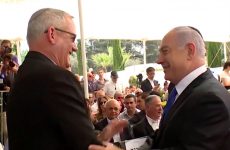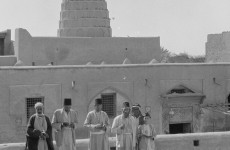 Prof. Joshua Ben Arieh: ‘Trilateral Land Exchange Is Only Viable Solution To Creating Jobs For Palestinians’
Prof. Joshua Ben Arieh: ‘Trilateral Land Exchange Is Only Viable Solution To Creating Jobs For Palestinians’
‘A Small Strip Of Sinai Seashore South Of Rafah Annexed To Gaza Strip; In Exchange, Israel Would Give Egypt Piece Of Negev For Land Link To Jordan & Arab World’
‘Need For Marshall Plan Aid Package To Include Rebuilding Of Egypt’s Outmoded Suez Canal’
What happens after Israel’s upcoming withdrawal from the Gaza Strip and 4 West Bank settlements? Geographer Joshua Ben-Arieh says he doesn’t know but he is certain of one thing; that unless jobs are created for the Palestinian residents of the Gaza Strip, the Roadmap is doomed to failure. Professor (Emeritus) Ben-Arieh of the Hebrew University has discussed his plan with Prime Minister Ariel Sharon and Palestinian officials. In this interview with IsraCast, Ben Arieh presents his program that may be put on the future Middle East agenda.
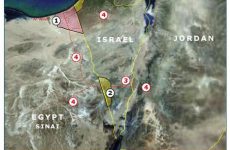
Prof. Joshua Ben-Arieh has presented a dynamic regional plan to create crucial jobs for Palestinians in the Gaza Strip, possibly after Israel’s upcoming withdrawal. Without an economic solution, Ben Arieh says there is no hope for the Roadmap.
The idea is a trilateral land swap involving the Gaza Strip, Egypt and Israel. Ben Arieh says 350,000 Palestinians were living in the 350 square kilometers of the Gaza Strip when it was conquered by the IDF in the Six-Day War of 1967. Today there are about 1,250,000 Palestinians there, maybe more. The Palestinian birth rate is very high, between 4-5 percent, meaning that in the year 2020 there will be some 2.5 million people living in this tiny area.
Prof. Ben-Arieh: What are you going to do with the people there? The disengagement will not solve this problem and I’m not saying whether the disengagement is good or not. You will leave there more than a million people in a cage, without giving them anything, and the problem is again not housing. You can build high-rise buildings like in Manhattan, like in other places, and accommodate the people there. But the main problem is what they will live on, they need jobs, and if you do not have an economic solution to this problem, it will break down. I believe any peace agreement that will not solve the problem of Gaza cannot be sustained. You have to try and find a solution for the concentration of people who live in the Gaza Strip.
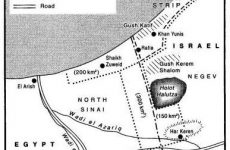 Question: This is the background and now after Israel carries out the disengagement, international aid will finance a massive housing project in the Gaza Strip. But what of a long term solution for the fast growing one million plus Palestinians? Here’s where Ben-Arieh’s plan comes in:
Question: This is the background and now after Israel carries out the disengagement, international aid will finance a massive housing project in the Gaza Strip. But what of a long term solution for the fast growing one million plus Palestinians? Here’s where Ben-Arieh’s plan comes in:
Prof. Ben-Arieh: People are saying let us make the Gaza Strip like Singapore, like Hong-Kong. First of all Singapore is 700 square kilometers but Singapore is an island, Singapore is a junction, its a crossroad. Why can so many people live in Singapore? Because there are important deep-water ports, international airports, its a center of commerce. In Hong-Kong, which is 1,000 square kilometers, there are about 8 million people, but this is the entrance to China, to one billion people. So you have to form the Gaza Strip so that it will become again a crossroad, a junction to many other places. In the situation that the Gaza Strip is now, its a closed area and you cannot do anything with it. It will be a waste of money building the houses there if you cannot find an economic solution, and I don’t see any other solution. In the Geneva Accord they suggested to widen the Gaza Strip by 2-3 kilometers to the west, toward the Israeli kibbutzim, which is again a problem, but what it will give? It will give 100 square kilometers but it will not solve the economic problems. In my opinion there is only one solution and if you will not do this solution you will not solve the problem. You have to open the barrier, what is called the Philadelphi barrier between Gaza to Sinai, and to annex a piece of land in Sinai; let us say between 500 to 1,000 square kilometers, thats all. Take 25 kilometers on the coast – from Rafah to El-Arish, there are about 45, take half of it, 25 kilometers. Then go inland 40 kilometers and you have 1,000 square kilometers. If you annex it, adding it to Sinai, you can develop its economic potential, which in this area is enormous in my opinion. You can build there a deep-water port, you can build there an international airport and for a real international airport you need open skies. You can build there a major city and there is a very cheap labor force in the Gaza Strip. The distance between Rafah and this area is a quarter of an hour drive or half an hour from Gaza. You can absorb there millions of people in my opinion.
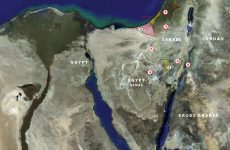 Question: So it sounds like an ideal solution – only one problem. That strip of Mediterranean coastline is Egyptian territory. What’s in it for Egypt? Ben- Arieh notes there is a recent precedent in the Middle East for a similar land exchange. In 1965, Jordan was interested in expanding its Red Sea port of Aqaba but lacked the required space. So the Jordanians turned to their Saudi Arabian neighbors for part of its coastline to the south. The negotiations resulted in a bilateral territorial exchange of between 6,000 and 7,000 square kilometers. Ben-Arieh’s Gaza proposal would amount to only about ten percent of the Jordanian-Saudi deal. The Egyptians would give up some territory south of Rafah but would be compensated with Israeli land in the Negev:
Question: So it sounds like an ideal solution – only one problem. That strip of Mediterranean coastline is Egyptian territory. What’s in it for Egypt? Ben- Arieh notes there is a recent precedent in the Middle East for a similar land exchange. In 1965, Jordan was interested in expanding its Red Sea port of Aqaba but lacked the required space. So the Jordanians turned to their Saudi Arabian neighbors for part of its coastline to the south. The negotiations resulted in a bilateral territorial exchange of between 6,000 and 7,000 square kilometers. Ben-Arieh’s Gaza proposal would amount to only about ten percent of the Jordanian-Saudi deal. The Egyptians would give up some territory south of Rafah but would be compensated with Israeli land in the Negev:
Prof. Ben-Arieh: So my idea is that Israel will give them a compensation of territory in the southern part of the Negev, there is a territory which is called the Faran valley or Plateau, it was once the Girafy wadi. If you take about 30-40 kilometers along the border to a depth of about 10-15 kilometers inside Israel, you get an area of between 250 to 500 square kilometers. Give it to the Egyptians for the territory that they give up and also add a road, a corridor that would connect this territory with Jordan. This would link Egypt to Jordan, to northern Saudi-Arabia, to Iraq, to Damascus – in a way it was the dream of Gamal Abed Al-Nasser in the 50’s to link the Magreb and the Mashrek (Arab states to the east of Egypt). It could be very important for the Egyptians because they could build a road, a railroad, from the city of Suez to Amman, Jordan and to Jedda, Mecca and Medina in Saudi Arabia. In a way its the new Darb el Hajj (Road of the Hajj pilgrimage, a modern one. They could develop it and this land bridge through the Negev would also link the deep-water port that could be built south of Rafah with Jordan. It would be an exit, an outlet, for all the transportation from Jordan, from Saudi-Arabia, even an oil-pipeline. So it becomes a regional plan that you are developing and you are solving the problem of the Israelis and the Palestinians. What I’m saying is that its not just an exchange of territory between Israel and Egypt, in a way its an exchange of territory between Israel and the Palestinians, like between Jordan and Saudi-Arabia. So what is Israel doing? It gives the Palestinians a piece of land in the Negev, so that they can use it to exchange territories with the Egyptians. And because Israel gives the Palestinians a piece of land, the Palestinians will be ready to use it for a land swap with Egypt that will give the Egyptians about 600-700 square kilometers inside the Green line (Israeli border).
Question: The Ben-Arieh plan sounds almost too good to be the true: the Palestinians gain, Israel gains and so does Egypt. But won’t this kind of regional plan depend on the inflow of massive international aid similar to the Marshall Plan launched by the U.S. to rebuild a devastated Western Europe after World War II?
 Prof. Ben-Arieh: Certainly, this is the advantage; it will not only be a solution between Israel and Palestinian Authority. First of all Egypt will be involved in it and in a way it can become an Egyptian initiative because the Egyptians can say they are contributing to resolving their own problems. You know today Egypt is a country of 70 million people. The Egyptian birth rate is also high, two thirds of the population there is under the age of forty. In 15 years, it will become a country of 120 million people. They need to find an economic solution and they need jobs no less than the Palestinians. The Egyptian population is concentrated only in the Nile Valley delta, an area of some 50,000 square kilometers. So the Egyptians can say: We will contribute our part without losing territory, and the world will help us to also solve our problem. The world could promise Egypt a Marshall plan for 10 years of economic aid. Take the Suez Canal that has many problems. This is a canal that was built in the 19th century; it is very narrow, it is not deep enough, its a one-way canal. The world can promise Egypt to build a parallel Suez Canal, and along it new cities could be developed. Companies could do it, American companies, French companies, British companies, the entire world. It would be an offensive of peace instead of an offensive of war.
Prof. Ben-Arieh: Certainly, this is the advantage; it will not only be a solution between Israel and Palestinian Authority. First of all Egypt will be involved in it and in a way it can become an Egyptian initiative because the Egyptians can say they are contributing to resolving their own problems. You know today Egypt is a country of 70 million people. The Egyptian birth rate is also high, two thirds of the population there is under the age of forty. In 15 years, it will become a country of 120 million people. They need to find an economic solution and they need jobs no less than the Palestinians. The Egyptian population is concentrated only in the Nile Valley delta, an area of some 50,000 square kilometers. So the Egyptians can say: We will contribute our part without losing territory, and the world will help us to also solve our problem. The world could promise Egypt a Marshall plan for 10 years of economic aid. Take the Suez Canal that has many problems. This is a canal that was built in the 19th century; it is very narrow, it is not deep enough, its a one-way canal. The world can promise Egypt to build a parallel Suez Canal, and along it new cities could be developed. Companies could do it, American companies, French companies, British companies, the entire world. It would be an offensive of peace instead of an offensive of war.
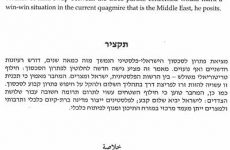 Question: Prof. Ben-Arieh goes on to say the Israeli-Palestinian dispute has become an international conflict. There are international ramifications leading to Al Qaeda, Iraq, the terrorism in London and elsewhere.
Question: Prof. Ben-Arieh goes on to say the Israeli-Palestinian dispute has become an international conflict. There are international ramifications leading to Al Qaeda, Iraq, the terrorism in London and elsewhere.
Prof. Ben-Arieh: Imagine if the world comes and says to the Palestinians, the Israelis and the Egyptians we will help you to solve the problem. The impact could affect all the Middle East and the entire world. But you need leadership for such a venture, someone has to take it in hand, I cannot do it. So with Bush and Chirac, who today enjoy good relations with both Sharon and Abu-Mazen, it could help the Palestinians. I say that its a win-win for the Palestinians, its a win-win for the Israelis and its a win-win for the Egyptians
When Ben-Arieh discussed his plan with Ariel Sharon some two years ago, the Prime Minister reacted by saying that top priority must be the curbing of Palestinian terror. Although the PM thought it was premature he kept the maps presented by Ben-Arieh. The PM did not reject it out of hand saying: ‘Maybe one day it can become an idea’. Ben-Arieh believes that day is fast approaching, perhaps after the disengagement.


